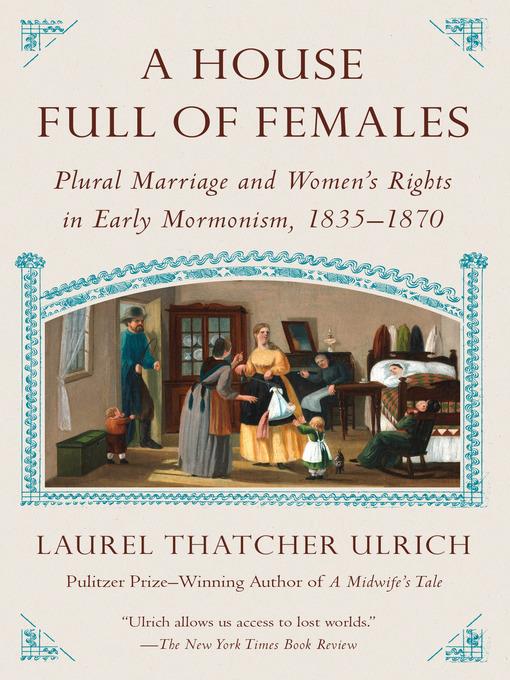
A House Full of Females
Plural Marriage and Women's Rights in Early Mormonism, 1835-1870
کتاب های مرتبط
- اطلاعات
- نقد و بررسی
- دیدگاه کاربران
نقد و بررسی

November 14, 2016
Pulitzer-winner Ulrich (A Midwife’s Tale) gives readers a day-to-day look at the hardships early Mormons endured as pioneers and religious outlaws but also takes a broader view of longer-term changes in the religion. The book opens dramatically with Mormon women being granted the right to vote, joining Elizabeth Cady Stanton and Susan B. Anthony’s crusade for women’s suffrage, and protesting an 1870 law ending polygamy. They acted out of patriotism, religious zealousness, and the belief that their church offered more equality than in the Gentile world—even though Brigham Young’s leadership was less inclusive than Joseph Smith’s and plural marriage had become a de facto requirement for the powerful. Still, women maintained the right to choose their spouses, and could also choose whether to be sealed to them for eternity. Impeccable scholarship and a fascinating topic suffer somewhat from the book’s organization. Each chapter moves ahead chronologically, but Ulrich also frequently jumps out of sequence, and because she writes about a fair number of people, many of whom have similar names, the problem multiplies. The author takes no view herself on the practice of plural marriage and simply presents history as it occurred, although in her acknowledgments she writes, “I did not find it odd that my father had both a grandmother... and a ‘Grandma on the hill.’ ”

November 1, 2016
A Pulitzer Prize-winning historian investigates women's power and agency within the early Mormon community.Ulrich (History/Harvard Univ.; Well-Behaved Women Seldom Make History, 2007, etc.), a MacArthur Fellow whose previous subjects have included colonial wives and early American midwives, has a personal investment in this deeply researched, well-informed history of marriage and family life among 19th-century Mormons: her eight great-grandparents and four great-great-grandparents migrated to Utah before 1860, and she grew up knowing that their stories included polygamy. Drawing on a rich trove of diaries and letters, the author follows many Mormon families as they confronted poverty, illness, privations, and persecution in their quest to establish a community where they could practice their faith and enact their social vision. She traces their journeys, beginning in 1835, from Ohio to Illinois, across the muddy flats of Iowa, to Nebraska, and finally, in 1850, to Salt Lake City. Plural marriage set the Latter-day Saints apart from many other sects eager to create an earthly utopia, and it stands as a puzzle that Ulrich can only partially explain. Some biographers accuse Mormon founder Joseph Smith of promoting the practice "to justify illicit relations with vulnerable young women," and Ulrich concedes, "there is some evidence to support that assumption." Smith and his successor, Brigham Young, both having multiple wives, defended polygamy as sanctioned by the Bible. Although some found it repugnant, many men took several wives, and women entered freely into those alliances. Some women saw marriage to a church leader as a path "to an elite inner circle." Not surprisingly, though, polygamy "generated conflict and gossip," anger and yearning. Besides considering the emotional toll of plural marriage, Ulrich questions the spiritual needs--and desire for authoritarian leadership-- that drew adherents to Mormonism and sustained their faith even under extreme duress. The trek west was marked by graves. While Ulrich creates an absorbing history of intimate lives, individuals' religious passions and acceptance of polygamy remain mysterious.
COPYRIGHT(2016) Kirkus Reviews, ALL RIGHTS RESERVED.

December 1, 2016
In her seventh book, historian Ulrich (A Midwife's Tale) turns her scholarly attention to the first generation of Latter-Day Saints (LDS). In a style familiar to those who have read her previous works, Ulrich offers a richly detailed social history of early Mormon daily life as documented by believers. Using diaries, letters, poetry, scrapbooks, meeting minutes, visual art, and textiles, the author carefully reconstructs the lives of women and men who converted to the faith and followed church leaders from Nauvoo, MO, to Utah. Through the words and actions of followers, we learn how this first generation digested controversial teachings, particularly around plural marriage, and how the hardships of life as religious radicals and refugees were shaped by gender. Beginning and ending with the federal government's (ultimately successful) late 19th-century efforts to outlaw plural marriage, this work promises more insight into the relationship between plural marriage and women's rights than it ultimately delivers. Nevertheless, this account does succeed in bringing women's experience back toward the center of early Mormonism's historical narrative. VERDICT Thoroughly researched and well-crafted, this work will be of interest to scholars and general readers with a strong background in 19th-century religious, social, and family history.--Anna J. Clutterbuck-Cook, Massachusetts Historical Soc.
Copyright 2016 Library Journal, LLC Used with permission.

November 15, 2016
Brigham Young will not soon join John Stuart Mill and Susan B. Anthony in the pantheon of nineteenth-century feminist icons. But in this surprising historical inquiry, Ulrich uncovers evidence that the system of polygamy over which Young presided opened up unusual opportunities for women to forge a civic identity. Through diaries kept by prominent Latter-day Saint women, such as Eliza R. Snow, Zina D. H. Young, and Bathsheba Smith, readers see how polygamous wives adapted toeven defendedmarital relationships that fostered an unusual sense of sisterhood in shared religious devotion and cooperative service. Though much of what such women did in the church's Female Relief Society involved traditionally female labors, the society did school women in grassroots organizing and public speaking. Ulrich consequently sees no mystery in the fact that Utah strongly supported Anthony's national crusade for women's suffrage and became only the second state to enfranchise women, and the first to elect a woman to the state senate. Probing scholarship sheds light on a little-understood chapter in American history.(Reprinted with permission of Booklist, copyright 2016, American Library Association.)

























دیدگاه کاربران